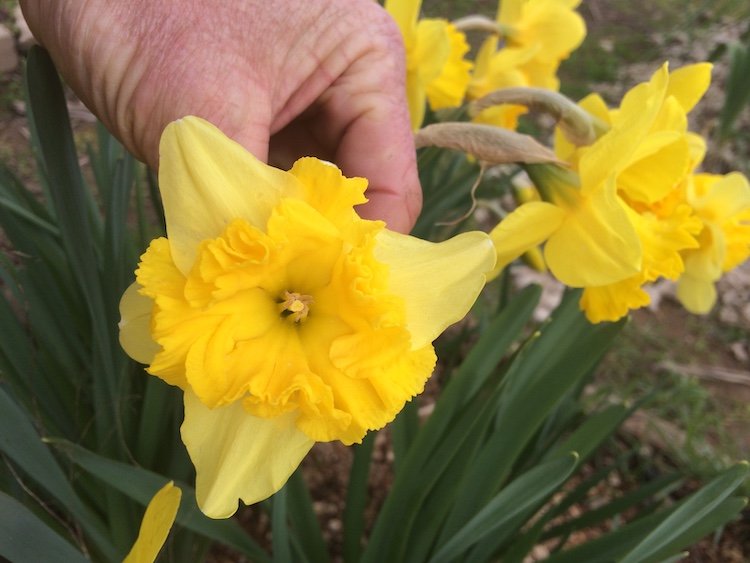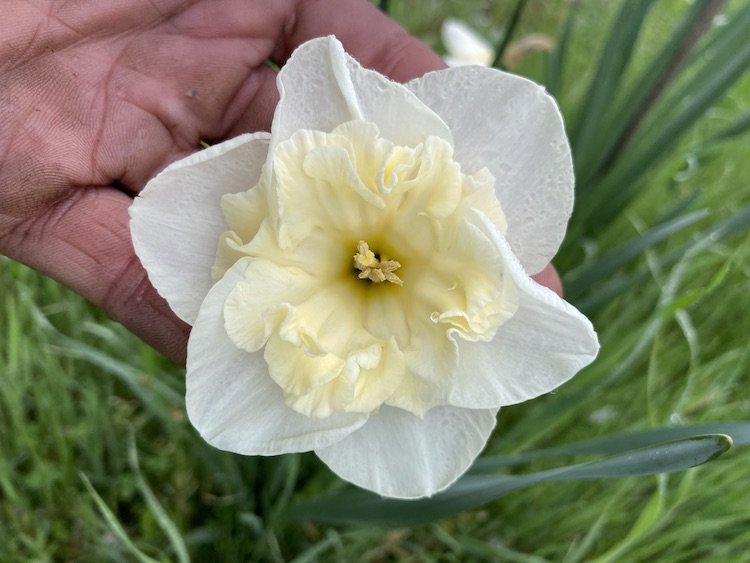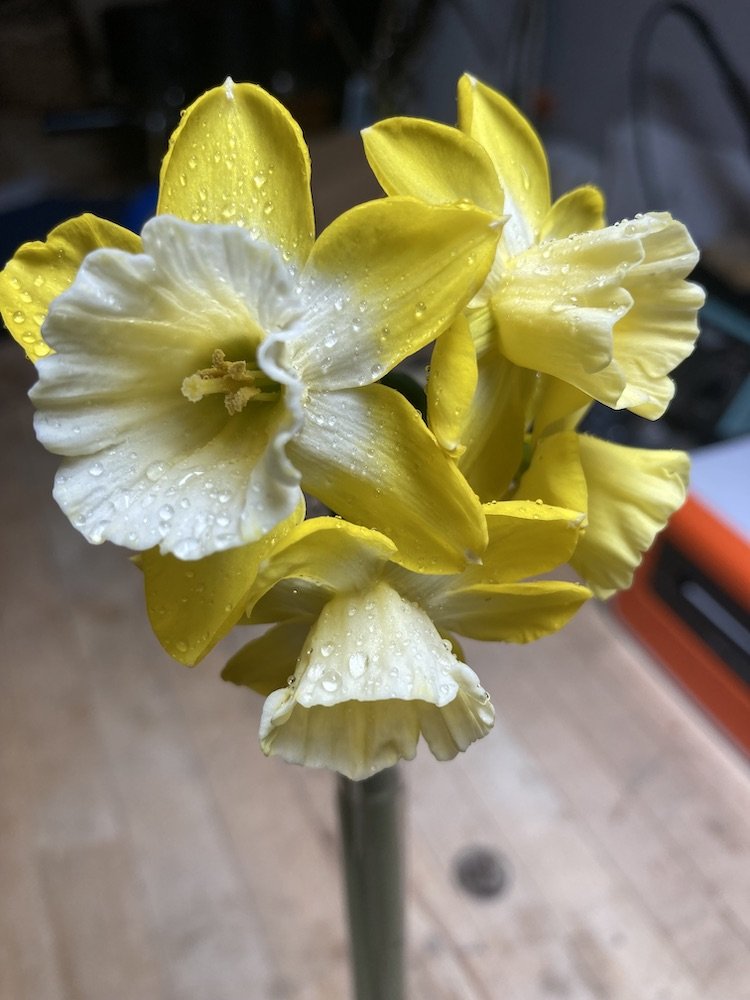Many years ago now, I became obsessed with daffodils and started breeding them. I will actually hardly take time to appreciate them, or “stop and smell the flowers” as they say. I’m just not that person. It’s really about the adventure and discovery for me. What is compelling to me is the anticipation, the thrill of the bloom season showing out new results, what can be done that hasn’t been done yet, and the next best-flower-ever always being just over the horizon. I like to say that with plant breeding, the process is as as valuable and compelling as the results. Being engaged and excited about something, the anticipation and investment, are all great things, regardless of the outcome.
My interest in this project slacked off somewhat for a while as I waited for the seedlings to bloom and show what kind of results I could expect. Earliest results were somewhat encouraging, but now that they are blooming in quantity, the results are very encouraging. I plan now to chase after the types that I want to breed a little more intentionally, and this year, I preordered some new bulbs for breeding stock. I’ll show you some promising new blooms and talk about plans and goals, but let’s get straight to the good stuff first!
I really like this flower. It is quite large and in my experience, pretty unique. It has an ethereal quality, translucent, pale and ghostly. The name will be something supernatural/paranormal like Spirit, Ghost, Apparition, Spirit Box, Ethereal etc. Photos do not do it justice. The color is graded and changes over time from yellow, fading into whitish or cream with a yellow rim and other yellow highlights, but the overall appearance is translucent and pale. (see second photo lower down the page).
This thing has attitude, crazy frilly corolla bits, with deep wrinkles, like some kind of tutu. But what really gives it the attitude is the swept back petals. In this photo it almost appears to have only three petals, because the others are swept back so far. I’m not sure I’ve seen a split cup appearing to have this much forward momentum. It’s a wild child. That might be the name, or Yellow Attitude or Party Girl or something edgy anyway. This girl can’t wait to fly the coop and leave her stodgy home town garden bed for good times broad! Good bulb division and producer of abundant flowers so far. Substance is a little weak compared to some modern heavy substance flowers, but it’s good enough.
This is a strange, ethereal and huge flower. It has to be seen in person to rub off right. It’s just weird. Translucent, large, kind of awkward but graceful, like some kind of giant organism that drifts through space living off stardust that happens to float into its corolla. Not sure if this space jellyfish will make it off the homestead, but it’s a keeper for the home place at least.
This thing is pretty epic, a very large and substantial split cup, with a very pleasing form and interesting subtle color grading. I was showing my friend Erin around the place when we ran into this for the first time, and we were both like, wow! (picture by Erin Kirschner) I was immediately thinking, “I would buy that from a catalogue”. If it shows to have good performance and consistently high quality blooms, I might pursue patenting and distribution through a large company. Who knows, maybe it will help pay for the new home place. I thought of calling it dominator, but would you believe it, there is already a daffodil by that name! I know, weird, but there are thousands of daff varieties and someone had to name all of them something. Dominatrix is available, but it just doesn’t sit right. Sorry ladies in leather, but as a spanker, not a spankee, I like to send a certain message wink wink. I might have to bust out the thesaurus and go for some other dominating name, like conquerer or conqueress. Seriously, this thing can compete with or beat most of the commercially available split cups I’ve flowered here. Maybe I’ll just call it “The Competition” But it still has to prove itself to perform, divide and flower well, and also show consistency in form. The color does not show well in photos, with yellow fading toward pinkish or peach in the center.
This one is just a very nice, very symmetrical simple yellow flower. It distinguishes itself for those qualities. I’m not a huge fan of these simple yellow daffs usually, but I have two that have stood out of the pack and this is one of them. I don’t have a picture of the other, but it’s very nice,with large forward facing flowers on a super tall stem. I showed this one to a girl that was visiting when it was blooming the first time and she said “It’s perfect”.
Here is a crazy psychedelic thing. This is a pink rimmed split cup. The reason it looks messed up is that it bloomed this first time in a weedy, sad bed in the field. Double flowers take a lot of resources, so if the plant is not growing under good culture, they just will not develop all the way. Hopefully with a better position in life it will develop evenly and completely. I thought I was really onto something new with this one, but I looked it up and there is one pink rimmed double out there in bulb catalogues already. It looks pretty similar to this actually. Even if this one doesn’t pan out, I know its possible now, so I’ll definitely try for more of them.
This is a really nice one. It almost appears to have a double center, but it’s just very frilled and folded. My friend Melissa suggested the name Marylin’s Skirt, which is the perfect reference.
A nice pink split cup. Certainly not like your Grandma’s daffodils! When selling daffs at farmer’s markets, exotic flowers like this get people’s attention.
One of the parents of this is hillstar. I have a few very similar seedlings, all pretty nice. I think this one has the most white/yellow contrast going on.
I have quite a lot of these pink rimmed types. That shows the power of building on previous work. Good pink rimmed daffs used to be very rare. With all the good breeding stock now, they can be improved further. Most of them are just adequate or similar to what is already out there, but at some point, one might really distinguish itself.
ghostly pale one as it looks when matured and faded, frilly attitude one and perfect symmetrical yellow. And a bee.
This project is very low input, but it turns out, maybe a little too low. I’ve lost a lot of young bulbs to things like late planting, weeds and just general procrastination and neglect I guess. I don’t need to up my game that much to have much better results though.
My usual approach is to go out in the late morning, pull off some anthers with pollen from some flower that I like, then go rub it on the girl parts of other flowers that I like. I don’t label anything. I go out and look for seed pods before they open and mix all the seeds together and plant them in flats during winter. After a couple years in the flat, they go into the ground. I’ve planted some in garden beds and some in the field. Field planting can work okay, but I’ve lost a lot to planting too early, or not controlling weeds and water. I know I’ve planted well over 1000, but I’m down to some many hundreds now. The part I need to improve the most is that flat to field transition.
It really starts with good breeding stock. If you want to breed good plants, stand on the shoulders of those who have already laid the groundwork for you. Chief among these for me is daffodil breeder Grant Mitsch who released many superior varieties in his lifetime. If you have to pay 10.00 or even 30.00 a bulb for breeding stock, but it will make all the difference in results, it’s worth it. Don’t start from the bottom, or even the middle if possible.
I am also increasingly chasing specific traits, so I’ll be making more pollinations for those. Chief among them is pink or red rimmed split cups. I have never seen one, though it is hard to imagine that no one has chased after or actually bred such a thing. Daffs with red or pink rimmed corollas are very common. The split part of a split cup daff is just a split corolla, so I can’t see why it wouldn’t work. I’ve been making a lot of crosses for that result for a while now, so I probably already have some new bulbs that will produce such flowers, but which have not flowered yet. I’m also going to try for more pink rimmed doubles. There is one commercially available already and that looks quite a bit like mine. I ordered it this year as much to compare to mine as for any other reason lol.
Once a good variety flowers, it still has to be propagated to make more. People already want them just from pictures that I’ve posted on instagram or in videos on YouTube. I want to make a lot of bulbs however, I really have to keep them all for a long time. Division is exponential of course, but still slow when you are starting with 1 to 3 bulbs! This year I will move the most promising seedlings that have flowered into protected, clean, well cared for beds to grow and divide. Every year or two, I can dig them and spread them out to keep them dividing as quickly as possible. There are other tricks to increase them faster, such as splitting the bases to produce quantities of bulblets, but I haven’t tried any of that yet.
I’ll also put the best varieties I have for breeding, into better situations, along with the new breeding stock, so that I’m getting plenty of good, well organized flowers all in the same area. I’ll continue making crosses for now and growing them out in flats and keep them there. Since I hope to be moving within a couple of years, I want to plant as few in the ground as possible. I am not looking at all forward to digging thousands of bulbs and replanting them somewhere else. I just had to dig out two garden beds of bulbs and now have hundreds to sort through, sell or replant, just to have to dig them up again later. But hey, if I can pull all that off, it’s going to be spectacular, because I have a gajillion bulbs!
I have a new system in mind of early weed control using tarping. When the fall rains come, I’ll let the herbs and grasses all sprout, but when they are still small, I’ll shade them out with heavy duty weed cloth. The flowers don’t emerge till quite a while after the first rains, so I can kill most of the weeds off for the rest of the year before the bulbs sprout up. I want to use that system to establish blocks of seedlings. If I keep the project going, every year those blocks will produce new flowers to assess, like a genetic treasure chest. And that’s the really fun part of the breeding process, going out to see what new treasures literally pop up out of the ground.
I think some people might think breeding plants is extremely complicated. It can be, but it often doesn’t need to be. Or they think that if something can be done, someone would already have done it. Nope. Plant breeding is far from tapped out. Certainly for the two plants I’ve worked with, apples and daffs. Daff breeding can be as simple as buying a bunch of bulbs of varieties you like from a catalogue, and when they flower, taking pollen from one you like and put it on the girl part of another one that you like. The only guideline I follow (mostly), is I use pollen from a color I want, like let’s say a red rim, and put it on a flower with the physical form I want, like a split cup. I read an article where a daffodil breeder said he does it that way, so I just do it mostly that way. That is as sophisticated as I will probably get with it.
My friend Mark Albert told me once that he used to sell vegetables at the farmer’s market, but eventually stopped and started to sell just flowers. Flowers make people happy. They think food should be dirt cheap and will complain about the price of good produce, but not about the price of flowers. I would probably never buy flowers for myself (or anyone else lol) but I like the smiles and happiness they seem to bring some people. If I could eventually get one or two apples or daffs that end up really spreading out there, that’s quite a legacy of enjoyment to unleash into the world. Each year, they produce the same fruit or flowers, regardless of age, potentially for generations to come. And maybe they will inspire other breeders or even be used as breeding stock.
Lust may be a strong word for my current relationship with daffodils and this project, but I’m certainly finding the results gratifying and the process compelling. Perhaps we’ve settled into a mutually beneficial LTR, puncuated by occasional exciting interludes. Look forward to more new flowers as they keep blooming. I’m hopeful that I’ll get new bulbs to flower quicker with better care, but out of the hundreds I already have growing, there are going to be many worthwhile new blooms. Out of those, I’m actually hopeful that I can market some on a large scale and generate some funds. So, with luck and work, maybe you’ll see my flowers in catalogues some day, propagated by the thousands and shipped all over the world. That would be pretty cool, to bring a lot of smiles to a lot of faces year after year for what seems like a relatively small effort.
Daffodil Lust II: The Breeding















